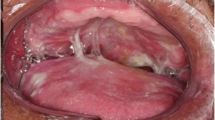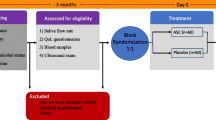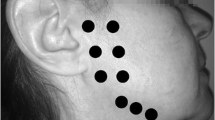Abstract
Xerostomia is a persistent side effect of radiotherapy (RT), which severely reduces the quality of life of the patients affected. Besides drug treatment and new irradiation strategies, surgical procedures aim for tissue protection of the submandibular gland. Using a new surgical approach, the submandibular gland was autotransplanted in 6 patients to the patient’s forearm for the period of RT and reimplanted into the floor of the mouth 2–3 months after completion of RT. Saxon’s test was performed during different time points to evaluate patient’s saliva production. Furthermore patients had to answer EORTC QLQ-HN35 questionnaire and visual analog scale. Following this two-stage autotransplantation, xerostomia in the patients was markedly reduced due to improved saliva production of the reimplanted gland. Whether this promising novel approach is a reliable treatment option for RT patients in general should be evaluated in further studies.




Similar content being viewed by others
References
Ramaekers BL, Joore MA, Grutters JP et al (2011) The impact of late treatment-toxicity on generic health-related quality of life in head and neck cancer patients after radiotherapy. Oral Oncol 47:768–774
Jensen SB, Pedersen AM, Vissink A et al (2010) A systematic review of salivary gland hypofunction and xerostomia induced by cancer therapies: prevalence, severity and impact on quality of life. Support Care Cancer 18:1039–1060
Nguyen NP, Sallah S, Karlsson U, Antoine JE (2002) Combined chemotherapy and radiation therapy for head and neck malignancies: quality of life issues. Cancer 15:1131–1141
Toledano I, Graff P, Serre A et al (2012) Intensity-modulated radiotherapy in head and neck cancer: results of the prospective study GORTEC 2004-03. Radiother Oncol 103:57–62
Nutting CM, Morden JP, Harrington KJ et al (2011) Parotid-sparing intensity modulated versus conventional radiotherapy in head and neck cancer (PARSPORT): a phase 3 multicentre randomised controlled trial. Lancet Oncol 12:127–136
Vergeer MR, Doornaert PA, Rietveld DH, Leemans CR, Slotman BJ, Langendijk JA (2009) Intensity-modulated radiotherapy reduces radiation-induced morbidity and improves health-related quality of life: results of a nonrandomized prospective study using a standardized follow-up program. Int J Radiat Oncol Biol Phys 74:1–8
Fisher J, Scott C, Scarantino CW et al (2003) Phase III quality-of-life study results: impact on patients’ quality of life to reducing xerostomia after radiotherapy for head-and-neck cancer–RTOG 97-09. Int J Rad Oncol Biol Phys 56:832–836
Horiot JC, Lipinski F, Schraub S et al (2000) Post-radiation severe xerostomia relieved by pilocarpine: a prospective French cooperative study. Radiother Oncol 55:233–239
LeVeque FG, Montgomery M, Potter D et al (1993) A multicenter, randomized, double-blind, placebo-controlled, dose-titration study of oral pilocarpine for treatment of radiation-induced xerostomia in head and neck cancer patients. J Clin Oncol 11:1124–1131
Bardet E, Martin L, Calais G et al (2011) Subcutaneous compared with intravenous administration of amifostine in patients with head and neck cancer receiving radiotherapy: final results of the GORTEC2000-02 phase III randomized trial. J Clin Oncol 29:127–133
Büntzel J, Glatzel M, Mücke R, Micke O, Bruns F (2007) Influence of amifostine on late radiation-toxicity in head and neck cancer—a follow up study. Anticancer Res 27:1953–1956
Kouvaris JR, Kouloulias VE, Vlahos LJ (2007) Amifostine: the first selective-target and broad spectrum radioprotector. Oncologist 12:738–747
Johnson JT, Ferretti GA, Nethery WJ et al (1993) Oral pilocarpine for post-irradiation xerostomia in patients with head and neck cancer. N Engl J Med 329:390–395
Rades D, Fehlauer F, Bajrovic A, Mahlmann B, Richter E, Alberti W (2004) Serious adverse effects of amifostine during radiotherapy in head and neck cancer patients. Radiother Oncol 70:261–264
Teymoortash A, Müller F, Juricko J et al (2009) Botulinum toxin prevents radiotherapy-induced salivary gland damage. Oral Oncol 45:737–739
Schneyer LH, Levin LK (1955) Rate of secretion by exogenously stimulated salivary gland pairs of man. J Appl Physiol 7:609–613
Jha N, Seikaly H, McGaw T, Coulter L (2000) Submandibular salivary gland transfer prevents radiation-induced xerostomia. Int J Radiat Oncol Biol Phys 46:7–11
Rieger JM, Jha N, Lam Tang JA, Harris J, Seikaly H (2012) Functional outcomes related to the prevention of radiation-induced xerostomia: oral pilocarpine versus submandibular gland transfer. Head Neck 34:168–174
Zhang Y, Guo CB, Zhang L et al (2012) Prevention of radiation-induced xerostomia by submandibular gland transfer. Head Neck 34:937–942
Liu XK, Su Y, Jha N et al (2011) Submandibular gland transfer for the prevention of radiation-induced xerostomia in patients with nasopharyngeal carcinoma: 5-year outcomes. Head Neck 33:389–395
Geerling G, Sieg P, Bastian GO, Laqua H (1998) Transplantation of the autologous submandibular gland for most severe cases of keratoconjunctivitis sicca. Ophthalmology 105:327–335
Song B, Zhang L, Liu XJ et al (2012) Proteomic analysis of secretion from human transplanted submandibular gland replacing lacrimal gland with severe keratoconjunctivitis sicca. Biochim Biophys Acta 1824:550–560
Borrelli M, Schröder C, Dart JK et al (2010) Long-term follow-up after submandibular gland transplantation in severe dry eyes secondary to cicatrizing conjunctivitis. Am J Ophthalmol 150:894–904
Yu GY, Zhu ZH, Mao C et al (2004) Microvascular autologous submandibular gland transfer in severe cases of keratoconjunctivitis. Int J Oral Maxillofac Surg 33:235–239
Kohler PF, Winter ME (1985) A quantitative test for xerostomia. The Saxon test, an oral equivalent of the Schirmer test. Arthritis Rheum 28:1128–1132
Jacobsen HC, Hakim SG, Trenkle T, Nitschke M, Steven P, Sieg P (2013) Allogenic submandibular gland transplantation following hematopoietic stem cell transplantation. J Craniomaxillofac Surg 41:764–769
Spiegel JH, Zhang F, Levin DE, Singer MI, Buncke HJ (2000) Microvascular transplantation of the rat submandibular gland. Plast Reconstr Surg 106:1326–1335
Spiegel JH, Deschler DG, Cheney ML (2001) Microvascular transplantation and replantation of the rabbit submandibular gland. Arch Otolaryngol Head Neck Surg 127:991–996
Spiegel JH, Brys AK, Bhakti A, Singer MI (2004) Metastasis to the submandibular gland in head and neck carcinomas. Head Neck 26:1064–1068
Genden EM, Ferlito A, Silver CE, Takes RP, Suárez C, Owen RP, Haigentz M, Stoeckli SJ, Shaha AR, Rapidis AD, Rodrigo JP, Rinaldo A (2010) Contemporary management of cancer of the oral cavity. Eur Arch Otorhinolaryngol 267(7):1001–1017
Author information
Authors and Affiliations
Corresponding author
Rights and permissions
About this article
Cite this article
Hagen, R., Scheich, M., Kleinsasser, N. et al. Two-stage autotransplantation of human submandibular gland: a novel approach to treat postradiogenic xerostomia. Eur Arch Otorhinolaryngol 273, 2217–2222 (2016). https://doi.org/10.1007/s00405-015-3752-0
Received:
Accepted:
Published:
Issue Date:
DOI: https://doi.org/10.1007/s00405-015-3752-0




